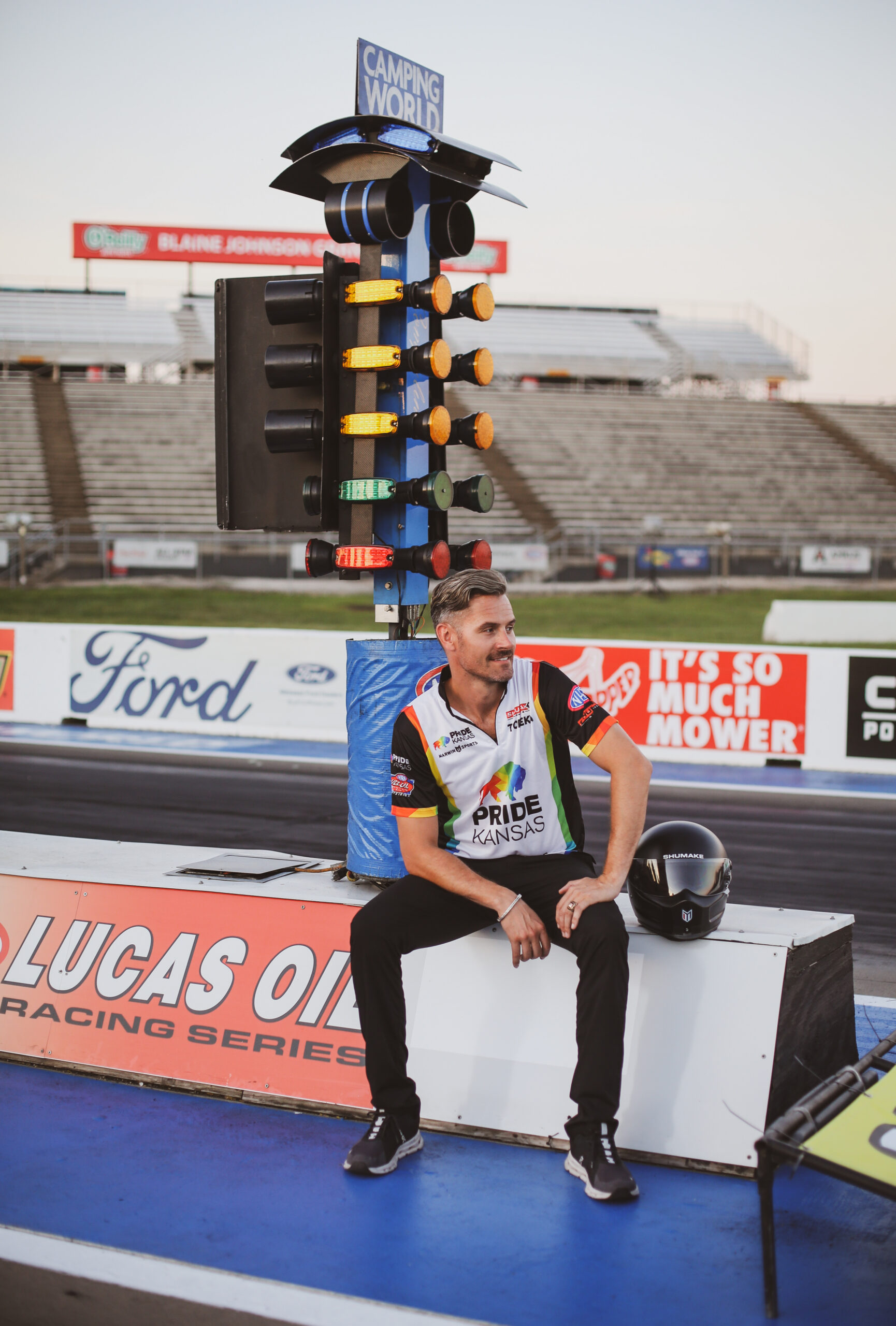Phoenix native Travis Shumake is breaking barriers as the first openly gay drag racer to compete in the NHRA
By Shelby Tuttle
Resiliency is in Travis Shumake’s DNA. I met him in December 2012 when we were thrown together to plan the New Year’s Eve grand opening of a swanky Downtown Phoenix rooftop bar. He was tall and attractive with a quick wit and boyish charm that made his 6-foot-4-inch frame seem less intimidating. He was smart and carried himself with a confidence that was steady but not boastful – he knew who he was as a person – something that I, at six years his senior, wasn’t really sure of myself at the time. What I also learned about Travis throughout the marathon-like grind and inevitable challenges we experienced setting up for that event, is that he was a person who intuitively knew how to roll with the punches; how to adjust, reposition, and move forward, as I imagine one does when faced with the behaviors, negative attitudes, and prejudices synonymous with coming out as a teen in the early 2000s.
Fast forward through the next 10 years in which he and I lost touch, to this last year as I quickly began to learn of his unusual journey following our successful planning endeavor all those years ago. Week after week, multiple updates began steadily pinging my LinkedIn account, illustrating that the path he charted for himself is truly as unique as he is – consisting of an impressive nonprofit fundraising career that includes three years at the Clinton Foundation and a present position with the Sigma Chi Foundation. Perhaps most prominently, as of last year, Travis is now the first openly gay drag racer to enter the National Hot Rod Association (NHRA).
The son of NHRA title-winning racer Tripp Shumake and Arizona Drag Racing Hall of Fame Inductee Susie Shumake, Travis has always had a plan to follow in his dad’s footsteps. He first raced shifter karts with his dad at North Phoenix’s PKRA, and in the late 90’s would run practice drills in the garage with his dad and girlfriend, NHRA funny car driver Paula Martin. But after his father’s sudden passing in 1999, Travis notes, “my family and I just kind of became fans.”
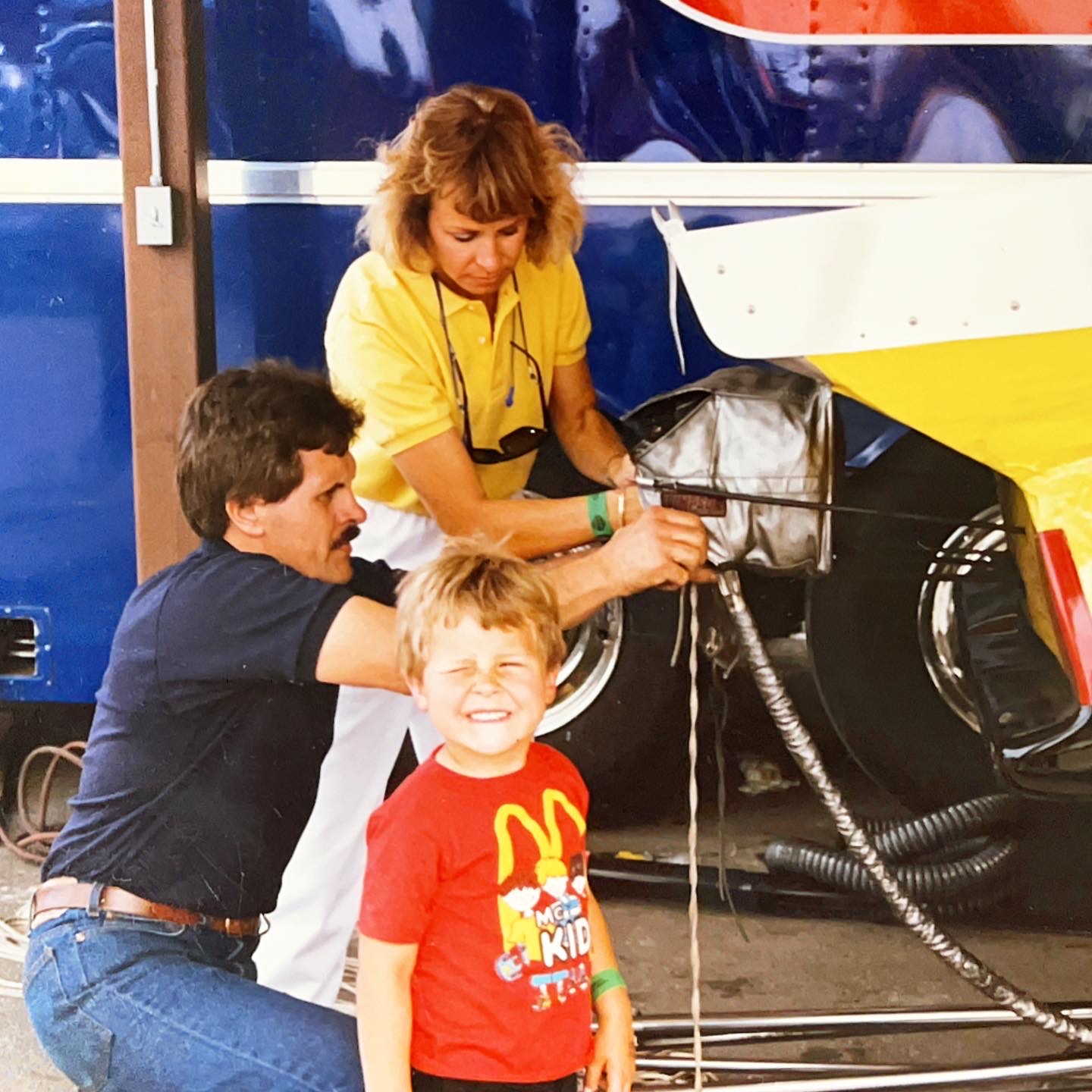
When COVID hit in 2020 and Travis found himself with a little more cash in his bank account, he decided to pursue his lifelong dream. Much like his dragster, the process was fast. His racing resume includes a whirlwind six-month process of attending professional driving school and a head-turning 319.26 mph-pass in a Nitro Funny Car which covered the race track in 3.96 seconds. He obtained four NHRA racing licenses and earned his stripes in a massive crash at 300 mph, absorbing 18 lateral G’s to the chest – which netted two broken ribs and a medevac off the race track. In April of last year, Travis made his NHRA debut in the top alcohol dragster category, winning hard-fought battles to procure his own funding and sponsorships, putting his top-tier fundraising skills to work – this time for himself.
His steady self-assuredness and unwavering dedication to his life-long dream was put to the test once more in August 2022, when he appeared in his first national event at Topeka’s Heartland Motorsports Park. There, his presence was protested by none other than the notoriously homophobic Westboro Baptist Church.
The group rose to infamy in 1998 during its protest of the funeral of Matthew Shepard, a gay University of Wyoming student who died after being savagely attacked and left for dead in a vicious hate crime. Members at the funeral carried signs that read “God Hates F***” (also featured in the church’s heinous URL) and “AIDS Kills F*** Dead.” Having sent out a press release to organize a protest of Travis’ involvement at the event, the church referred to him as “a Sodomite reprobate…who comes fully equipped with a rainbow colored vehicle… racing to perdition like the New Testament’s swine over cliffs.” Protesters gathered outside the venue for three days, donning signs with large block letters that read “F*** Doom Nations” and “Fear God and Keep His Commandments.”
Undaunted by their presence, Travis made his national debut under the Randy Meyer moniker, qualifying for his first-ever national event in a rainbow-colored 4,000-horsepower dragster sponsored by Visit Topeka and Pride Kansas.
“You know you’ve made it when you’ve been protested by the Westboro Baptist Church,” he jokes.
Strangely, he’s not wrong. Within the next 60 days, the church also protested against Michael Bublé for having a gay uncle ahead of his concert in Kansas City, Mo. and picketed outside a Paramore concert in Bonner Springs, citing the band’s “feverish” pursuits of “success, pride, lust, fame, and fortune.”
Travis brushes the severity of the protest aside.
“Visit Topeka signed on as my first major sponsor in an effort to show the country how welcoming and diverse the heartland can be. Those protestors aren’t a reflection of Topeka and certainly didn’t ruffle my feathers.”
But his natural animation and high energy slows in this moment to share a meaningful reflection.
“One of my closest relationships in racing is with a favorite mentor of mine, Del Worsham. And one of the most inspiring things he said to me was after I hit the wall and ripped his funny car in half during a testing pass in Las Vegas. He said, ‘You know, everyone’s worried about you coming out of this wreck and how you’re gonna feel. All eyes are on you, and people are talking about you. I told my wife that you’ve probably dealt with that your whole life, and you were meant to be resilient in these situations because of what you’ve gone through as a gay man. I told her that I assume you’re gonna be just fine.’ Wow. Such a wise thing to say.”
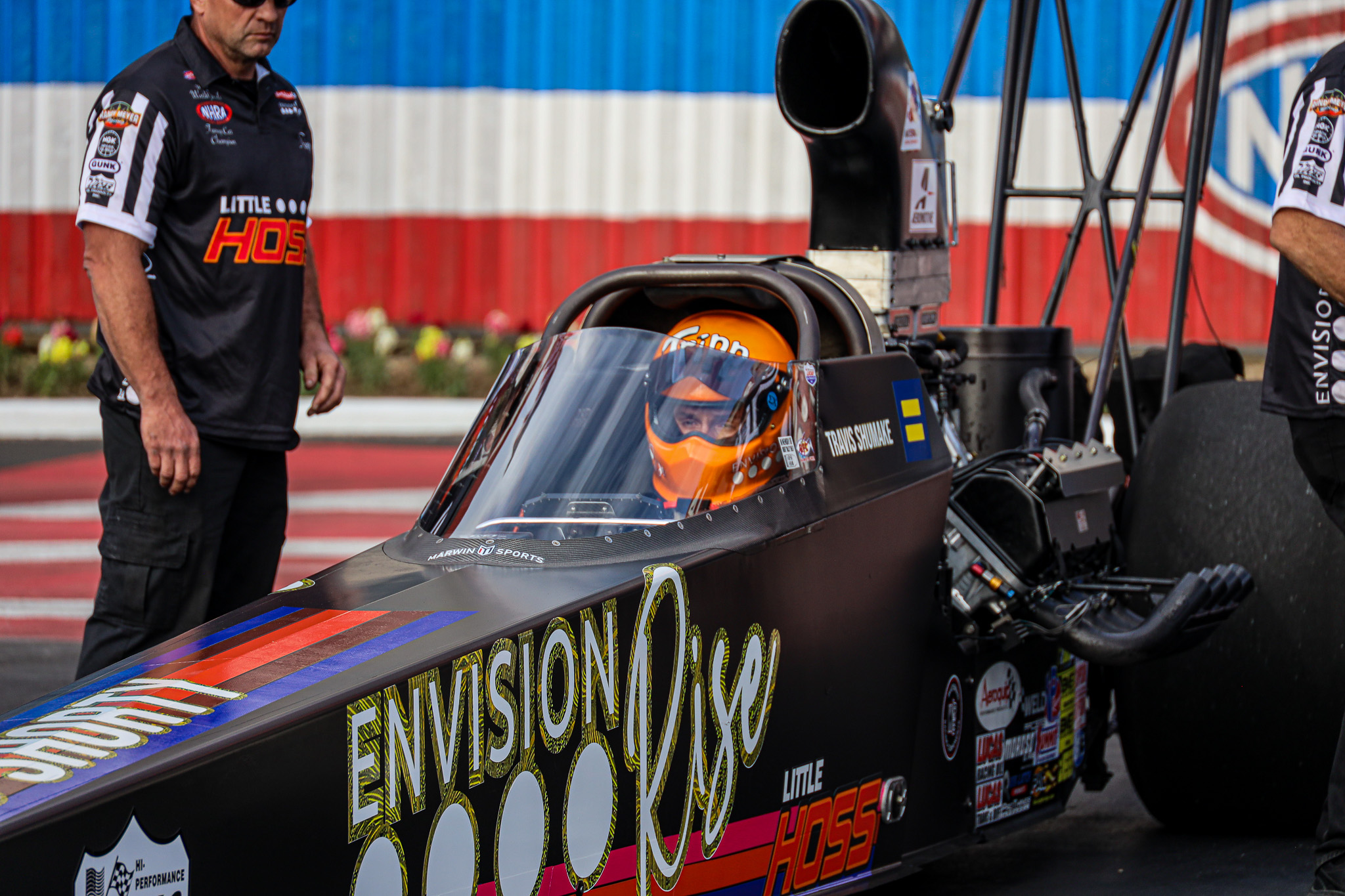
As we continue our discussion about the protest, he points out the diverse history of the NHRA – one that includes female, Black,, and Hispanic drivers that spans several decades, making it the most inclusive of all motorsports divisions. Still, the absence of an openly gay driver until now raises questions about the sport’s culture.
“There have been gay race car drivers, plenty of them. I’m not the first. I’d say I’m the 53rd,” he laughs. “Historically, the prevailing attitude is that it’s not a big deal, and you should just keep it to yourself. Someone once posted online that if I’m special for being gay, then he was special for being circumcised. For all of the LGBTQ+ people involved in the sport who aren’t comfortable coming out because of this implied ‘don’t ask, don’t tell’ mentality, it is a big deal.”
From Travis’ perspective, he found that the protest had the opposite effect of the church’s intention. It brought to the surface long-buried conversations within the industry and provided representation for a demographic of fans that – until just a couple of months earlier – didn’t see people like themselves in the sport.
“It gave people an excuse to come up to me to not only offer their support, but share that my being there meant something to them,” he said. “Like a gay old couple walked up, sunburned in their drag racing t-shirts and said, ‘We’ve been out here for 50 years.This is awesome.’”
Then there’s the camaraderie being created behind the scenes with Travis and fellow drivers, crew members, and sponsors connected to various teams that are not yet comfortable going public with their LGBTQ+ status.
“It was weird at first to get encouraging notes in my DM’s from people across motorsports saying they were looking forward to meeting me at some point” he says. “It took time for me to understand that some were gravitating towards me because I felt safe to them or made them comfortable with whatever they were going through. Some are facing their own hesitations and fears about coming out, and others are processing news of someone close to them that recently came out. We have a ton of allies out there who just needed a reason to raise their voices. Despite it being a very diverse and welcoming space, there is certainly so much room to grow.”
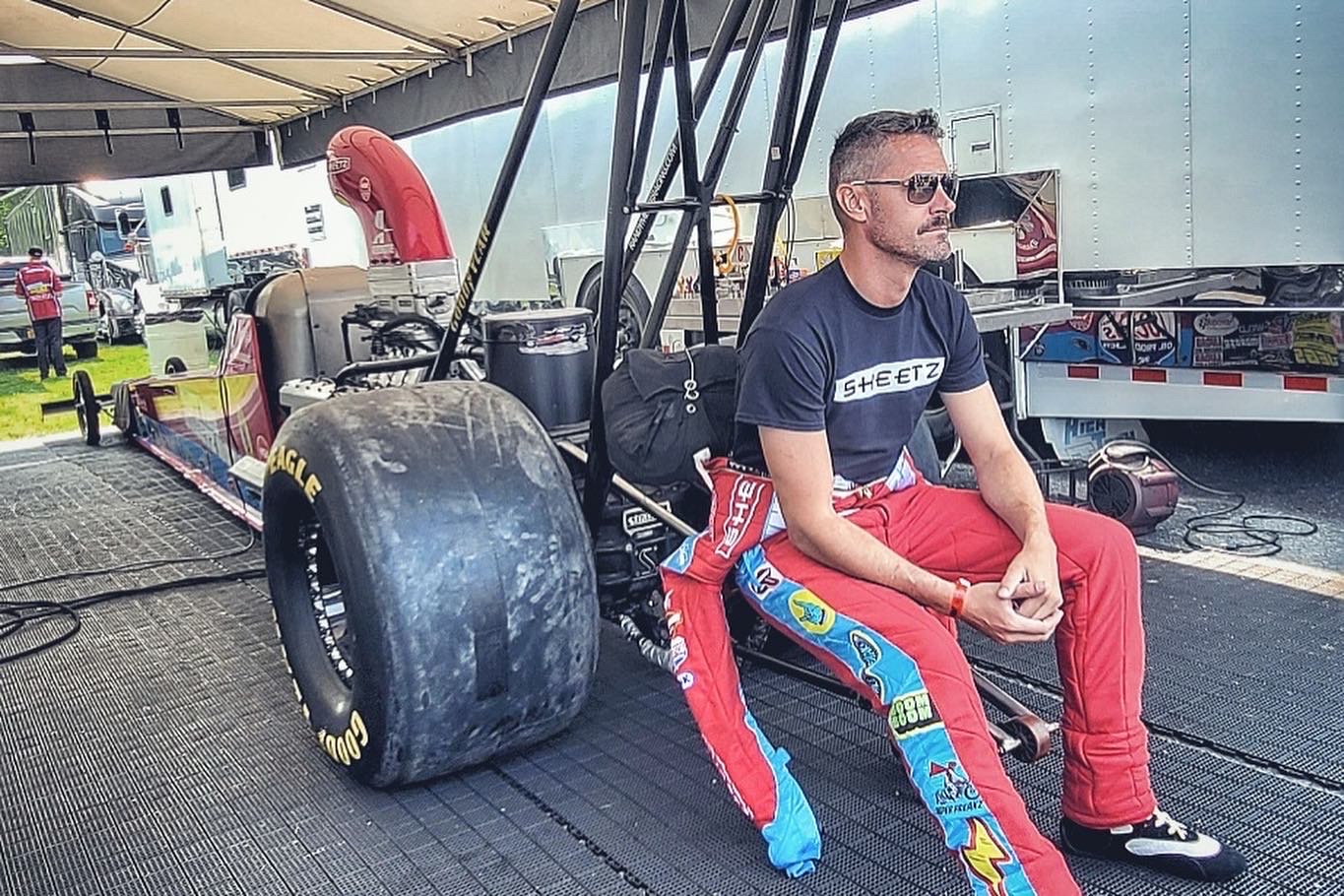
He likens his recent entry into the NHRA to Bubba Wallace’s entry into NASCAR.
“When Bubba came onto the scene, his presence stirred up a lot of stuff – and with it, relationships were challenged and broken behind the scenes because certain people didn’t believe he should be there. A change like this can fracture a sport if you let it. Now, Bubba is a household name and people are talking about his driving, not his race,” he said. “It’s the same for me currently. Some people celebrate my presence, while others detest it, and there are some relationships that have been impacted. I’m cognizant that my presence has an effect behind the scenes and can affect other people – but I can’t hide or be afraid of the conversations that people are having. In turn, I’ve got to have my own. All of these are crucial to determining who I want to align myself with for the long run.”
For Travis, driving for the winningest team in top alcohol dragster history can come with a unique set of challenges. With a team of six drivers and only two dragsters, he is constantly jockeying for seat time. His opportunities to compete – based on an ever-evolving combination of seniority, sponsorship dollars, and “home track” location – can change from season to season. For 2023, he was confirmed for just three of more than 25 races – down two from last year – after two of his senior teammates secured primary funding for the majority of the season.
“Life has a way of moving us forward in different ways that perhaps we weren’t prepared for or planning on,” he says. “Last season I was able to secure sponsors for every race that the car was available to me. I’m ready to raise more money and bring additional dollars, sponsors, and eyes to our sport.”
He confides, “It’s time to start building my own team.”
This move would make him not only the first openly gay driver in NHRA history, but the first openly gay owner of a professional American motorsports team.
When asked what it would take to own his own team, Travis shares that the real renaissance of the NHRA has come in the last few years and focuses more on the financial restructuring of the sport more than anything else. The league has seen a change attributed to individual team owners operating on far smaller budgets than what was thought to be required to compete in the sport.
“The bigger teams – the ones with a lot of money and multiple semi-trucks – can spend upwards of $100K to operate one dragster for one race weekend,” he notes. “I know a handful of independent teams that can operate for much less and do it well. They may not put a new engine in after every round – but they can make it work by taking care of their parts and racing smart. Of course, I’d love to do it all one day with a big budget, but that doesn’t mean I can’t do it for less.”
His plan for the 2023 season is to graduate up a class, from top alcohol to top fuel – a move that requires yet another license and takes him from operating a vehicle with 4,000 horsepower to one that will require him to tame 11,000 wicked little ponies. Just two weeks after winning Athlete of the Year at the Compete Sports Diversity Awards in Las Vegas, Travis proudly put a deposit on a dragster that will propel his dreams forward.
“I’m a proud millennial lifetime renter, and the first asset I’m gonna own in life is a top fuel dragster,” he says amused. “It’s bananas. If you know of anyone looking to raise eyebrows and go halfsies on a professional race team, let me know!”
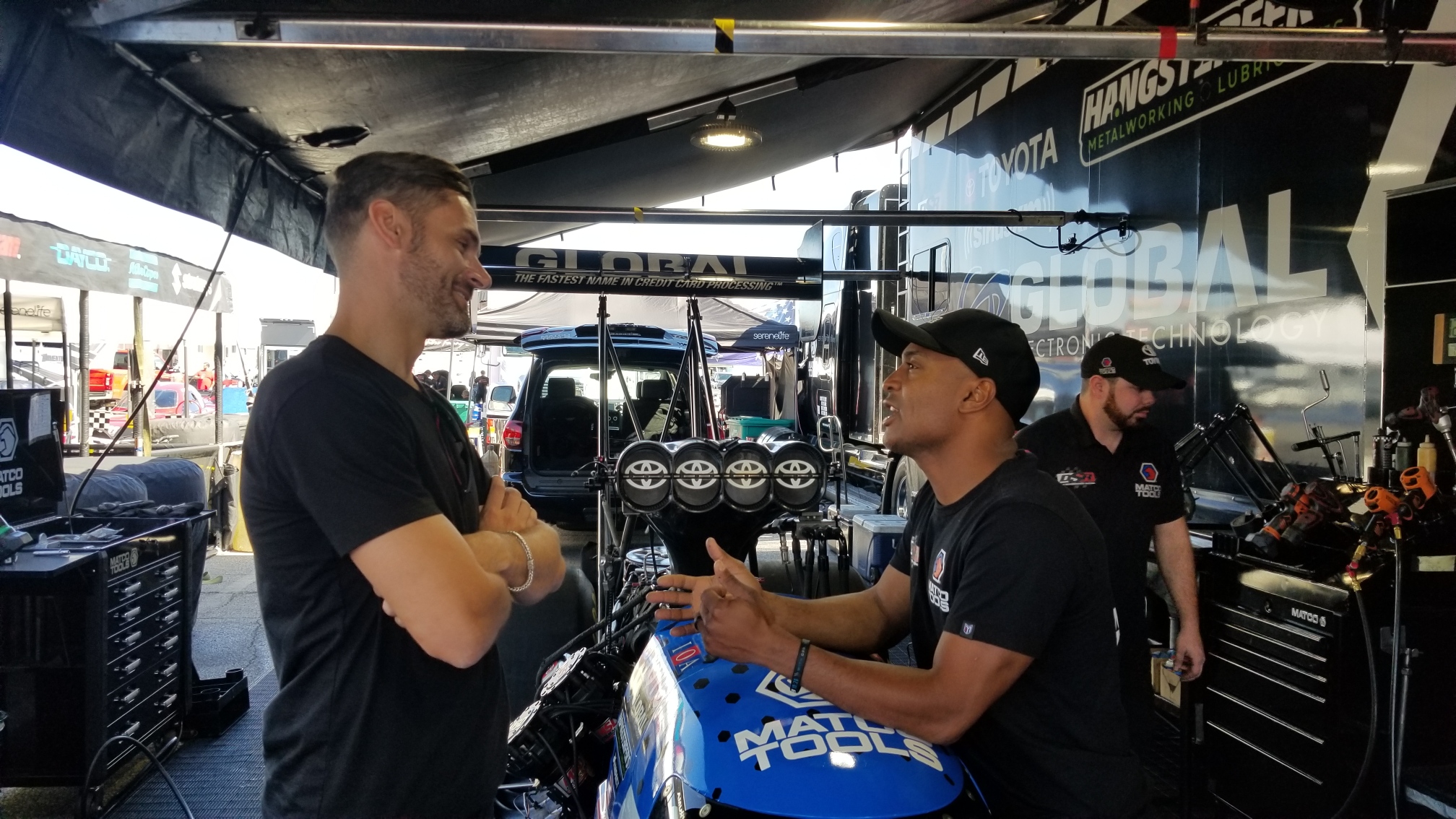
He shares that although he didn’t plan to own a team this early in his career, the freedom it brings greatly outweighs the financial hardship and hustle that comes with starting a team of this magnitude.
“My dad got paid to drive, whereas in my first season, I was raising every sponsorship dollar that got me on the track for those five events,” he said. “I’ll still be doing that next season, but having the freedom to wholly align myself with products, companies, and people that want to be on the right side of motorsports history is incredibly empowering.”
Travis also notes that along with this new freedom comes not only the responsibility of continuing to create conversations about LGBTQ+ involvement in the sport, but to attract new fans and implement initiatives that do right by the environment.
“When I’m driving someone else’s car, I can’t dictate that we plant 100 trees to offset the carbon emissions burned by the semi truck on the way to the track, or come up with my own initiatives to balance the pollution created by my car. But with my own team, I have the ability to explore what being more environmentally friendly looks like in drag racing and share that knowledge with other teams.”
Currently, the NHRA is testing electric dragsters that exceed 200 mph and are engineered by the sport’s rear engine dragster pioneer, Don Garlits.
According to Travis, “These additions may scare people who think that electric dragsters mean the end of drag racing as we know it. I disagree. I think it amplifies what we are doing and opens exciting opportunities to attract new fans, manufacturers, and sponsors to our sport.”
Presently, Travis intends to spend the first half of the 2023 season earning his top fuel license and learning the intricacies of the 330 mph nitromethane-fueled dragster he will soon call his own. With the help of current sponsors Sheetz Convenience Stores, Grindr, and Envision Rise, he plans to make his top fuel debut in the fall. Although he dreamt of running on his dad’s home track in next month’s NHRA Arizona Nationals – the finale event to be held at Wild Horse Pass Motorsports Park before it’s torn down later this year – he’s going to sit this one out with the prospect of bigger and better things on the horizon. He’s going to do the thing that I observed him doing best all those years ago – adjust, reevaluate, and roll with the punches. For more information on Travis, visit travisshumake.com.


